Effects of Prescribed Burning on Surface Dead Fuel and Potential Fire Behavior in Pinus yunnanensis in Central Yunnan Province, China
Abstract
:1. Introduction
2. Materials and Methods
2.1. Description of the Study Area
2.2. Field Sampling Description
2.3. Sample Analysis
2.3.1. Determination of FMC
2.3.2. Determination of HHV
2.3.3. Determination of Ash
2.3.4. Determination of Fat
2.4. Potential Fire Behavior Testing
2.5. Statistical Analysis
3. Results
3.1. Forest Stand Characteristics of P. yunnanensis Forest
3.2. Effect of Prescribed Burning on the P. yunnanensis Forest
3.2.1. Fuel Bed Structure
3.2.2. Physical and Chemical Properties of Surface Dead Fuel
3.2.3. Potential Fire Behavior of Surface Dead Fuels
3.2.4. Pearson Correlation of Surface Dead Fuels
3.3. Effect of Different Burn Treatments
3.3.1. Physical and Chemical Properties
3.3.2. Potential Fire Behavior
4. Discussion
4.1. Forest Stand Characteristics of P. yunnanensis Forest
4.2. Changes in Surface Dead Fuel in P. yunnanensis Forests
4.3. Impacts on Understory Species of P. yunnanensis Forests
4.4. Management Implications
5. Conclusions
Author Contributions
Funding
Data Availability Statement
Acknowledgments
Conflicts of Interest
References
- Wu, Z.; He, H.S.; Keane, R.E.; Zhu, Z.; Shan, Y. Current and future patterns of forest fire occurrence in China. Int. J. Wildland Fire 2020, 29, 104. [Google Scholar] [CrossRef]
- Urbanski, S. Wildland fire emissions, carbon, and climate: Emission factors. For. Ecol. Manag. 2014, 317, 51–60. [Google Scholar] [CrossRef]
- Arroyo, L.A.; Pascual, C.; Manzanera, J.A. Fire models and methods to map fuel types: The role of remote sensing. For. Ecol. Manag. 2008, 256, 1239–1252. [Google Scholar] [CrossRef]
- Zylstra, P. Flammability dynamics in the Australian Alps: Fact sheet. Austral Ecol. 2018, 12, 594. [Google Scholar]
- Keeley, J.E. Ecology and evolution of pine life histories. Ann. For. Sci. 2012, 69, 445–453. [Google Scholar] [CrossRef]
- Pausas, J.G. Evolutionary fire ecology: Lessons learned from pines. Trends Plant Sci. 2015, 20, 318–324. [Google Scholar] [CrossRef]
- Tian, X.; Shu, L.; Zhao, F.; Wang, M. Forest Fire Danger Changes for Southwest China under Future Scenarios. Sci. Silvae Sin. 2012, 48, 121–125+192–193. [Google Scholar]
- Wang, Q.; Shan, B.; Gong, J.; Pu, J. A Study on Prescribed Burning in Pure Forest of Pinus yunnanensis Franch in Central Yunnan Province. Acta Agric. Univ. Jiangxiensis 2018, 40, 235–240. [Google Scholar]
- Su, W.; Si, H.; Zhang, H.; Guo, Z. Fire-adapted traits of four pine trees in the southwestern China. Acta Ecol. Sin. 2023, 43, 1064–1072. [Google Scholar]
- Casals, P.; Valor, T.; Besalú, A.; Molina-Terrén, D. Understory fuel load and structure eight to nine years after prescribed burning in Mediterranean pine forests. For. Ecol. Manag. 2016, 362, 156–168. [Google Scholar] [CrossRef]
- Pereira, P.; Úbeda, X.; Martin, D.; Mataix-Solera, J.; Guerrero, X.C. Effects of a low severity prescribed fire on water-soluble elements in ash from a cork oak (Quercus suber) forest located in the northeast of the Iberian Peninsula. Environ. Res. 2011, 111, 237–247. [Google Scholar] [CrossRef] [PubMed]
- Bassett, T.J.; Landis, D.A.; Brudvig, L.A. Effects of experimental prescribed fire and tree thinning on oak savanna understory plant communities and ecosystem structure. For. Ecol. Manag. 2020, 464, 118047. [Google Scholar] [CrossRef]
- Valor, T.; Casals, P.; Altieri, S.; González-Olabarria, J.R.; Piqué, M.; Battipaglia, G. Disentangling the effects of crown scorch and competition release on the physiological and growth response of Pinus halepensis Mill using d13C and d18O isotopes. For. Ecol. Manag. 2018, 424, 276–287. [Google Scholar] [CrossRef]
- Molina, J.R.; Ortega, M.; Silva, F.R.Y. Scorch height and volume modeling in prescribed fires: Effects of canopy gaps in Pinus pinaster stands in Southern Europe. For. Ecol. Manag. 2021, 506, 119979. [Google Scholar] [CrossRef]
- Javier, M.; Gustavo, M.L.; de Nascimento, R.; Otto, A. Understanding long-term post-fire regeneration of a fire-resistant pine species. Ann. For. Sci. 2015, 72, 609–619. [Google Scholar]
- Wu, Z.; He, H.; Liu, Z.; Liang, Y. Comparing fuel reduction treatments for reducing wildfire size and intensity in a boreal forest landscape of northeastern China. Sci. Total Environ. 2013, 454–455, 30–39. [Google Scholar] [CrossRef]
- Kauppi, P.; Hanewinkel, M.; Lundmark, T.; Nabuurs, G.J.; Trasobares, A. Climate Smart Forestry in Europe; European Forest Institute: Joensuu, Finland, 2018. [Google Scholar]
- Defossé, G.E.; Loguercio, G.; Oddi, F.J.; Molina, J.C.; Kraus, P.D. Potential CO2 emissions mitigation through forest prescribed burning: A case study in Patagonia, Argentina. For. Ecol. Manag. 2011, 261, 2243–2254. [Google Scholar] [CrossRef]
- Ewers, F.W. Secondary growth in needle leaves of Pinus longaeva (bristlecone pine) and other conifers: Quantitative data. Am. J. Bot. 1982, 69, 1552–1559. [Google Scholar] [CrossRef]
- Su, W.; Zhang, J.; Shi, G.; Wang, Z.; Zhao, L.; Zhou, R. Comparison of the canopy and soil seed banks of Pinus yunnanensis in central Yunnan, China. For. Ecol. Manag. 2019, 437, 41–48. [Google Scholar] [CrossRef]
- Altangerel, K.; Kull, C.A. The prescribed burning debate in Australia: Conflicts and compatibilities. J. Environ. Plan. Manag. 2013, 56, 103–120. [Google Scholar] [CrossRef]
- Arévalo, J.R.; Bernardos, M.; González-Montelongo, C.; Grillo, F. Prescribed Burning Effect on the Richness, Diversity and Forest Structure of an Endemic Reforested Pinus canariensis Stand (Canary Islands). Fire 2023, 6, 150. [Google Scholar] [CrossRef]
- Liu, X.; Huey, L.G.; Yokelson, R.J.; Selimovic, V.; Simpson, I.J.; Müller, M.; Jimenez, J.L.; Campuzano-Jost, P.; Beyersdorf, A.J.; Blake, D.R. Airborne measurements of western US wildfire emissions: Comparison with prescribed burning and air quality implications. J. Geophys. Res. Atmos. 2017, 122, 6108–6129. [Google Scholar] [CrossRef]
- Shakesby, R.A.; Bento, C.P.M.; Ferreira, C.S.S.; Ferreira, A.J.D.; Stoof, C.R.; Urbanek, E.; Walsh, R.P.D. Impacts of prescribed fire on soil loss and soil quality: An assessment based on an experimentally-burned catchment in central Portugal. Catena 2015, 128, 278–293. [Google Scholar] [CrossRef]
- Hu, T.; Zhao, B.; Li, F.; Dou, X.; Hu, H.; Sun, L. Effects of fire on soil respiration and its components in a Dahurian larch (Larix gmelinii) forest in northeast China: Implications for forest ecosystem carbon cycling. Geoderma 2021, 402, 115273. [Google Scholar] [CrossRef]
- Hu, T.; Sun, L.; Hu, H.; Guo, F. Effects of fire disturbance on soil respiration in the non-growing season in a Larix gmelinii forest in the Daxing’an Mountains, China. PLoS ONE 2017, 12, e0180214. [Google Scholar] [CrossRef]
- Alexander, H.D.; Arthur, M.A.; Loftis, D.L.; Green, S.R. Survival and growth of upland oak and co-occurring competitor seedlings following single and repeated prescribed fires. For. Ecol. Manag. 2008, 256, 1021–1030. [Google Scholar] [CrossRef]
- Bradshaw, S.D.; Dixon, K.W.; Lambers, H.; Cross, A.T.; Hopper, S.D. Understanding the long-term impact of prescribed burning in mediterranean-climate biodiversity hotspots, with a focus on south-Western Australia. Int. J. Wildland Fire 2018, 27, 643. [Google Scholar] [CrossRef]
- Batista, E.K.; Figueira, J.E.; Solar, R.R.; de Azevedo, C.S.; Beirão, M.V.; Berlinck, C.N.; Brandão, R.A.; de Castro, F.S.; Costa, H.C.; Costa, L.M. In Case of Fire, Escape or Die: A Trait-Based Approach for Identifying Animal Species Threatened by Fire. Fire 2023, 6, 242. [Google Scholar] [CrossRef]
- Battaglia, M.A.; Smith, F.W.; Shepperd, W.D. Can prescribed fire be used to maintain fuel treatment effectiveness over time in Black Hills ponderosa pine forests? For. Ecol. Manag. 2008, 256, 2029–2038. [Google Scholar] [CrossRef]
- Prichard, S.J.; Kennedy, M.C.; Wright, C.S.; Cronan, J.B.; Ottmar, R.D. Predicting forest floor and woody fuel consumption from prescribed burns in southern and western pine ecosystems of the United States. Data Brief 2017, 15, 328–338. [Google Scholar] [CrossRef]
- Westerling, A.L.; Hidalgo, H.G.; Cayan, D.R.; Swetnam, T.W. Warming and Earlier Spring Increase Western U.S. Forest Wildfire Activity. Science 2006, 313, 940–943. [Google Scholar] [CrossRef]
- Moreira, F.; Viedma, O.; Arianoutsou, M.; Curt, T.; Koutsias, N.; Rigolot, E.; Barbati, A.; Corona, P.; Vaz, P.; Xanthopoulos, G.; et al. Landscape—Wildfire interactions in southern Europe: Implications for landscape management. J. Environ. Manag. 2011, 92, 2389–2402. [Google Scholar] [CrossRef]
- Tapias, R.; Climent, J.; Pardos, J.A.; Gil, L. Life histories of Mediterranean pines. Plant Ecol. 2004, 171, 53–68. [Google Scholar] [CrossRef]
- Tang, C.Q.; He, L.Y.; Su, W.H.; Zhang, G.F.; Wang, H.C.; Peng, M.C.; Wu, Z.L.; Wang, C.Y. Regeneration, recovery and succession of a Pinus yunnanensis community five years after a mega-fire in central Yunnan, China. For. Ecol. Manag. 2013, 294, 188–196. [Google Scholar] [CrossRef]
- Hong, R.; Li, J.; Wang, J.; Zhu, X.; Li, X.; Ma, C.; Cao, H.; Wang, L.; Wang, Q. Effects of prescribed burning on understory Quercus species of Pinus yunnanensis forest. Front. For. Glob. Chang. 2023, 6, 1208682. [Google Scholar] [CrossRef]
- Reich, R.M.; Lundquist, J.E.; Bravo, V.A. Spatial models for estimating fuel loads in the Black Hills, South Dakota, USA. Int. J. Wildland Fire 2004, 13, 119–129. [Google Scholar] [CrossRef]
- Bowyer, P.; Danson, F.M. Sensitivity of spectral reflectance to variation in live fuel moisture content at leaf and canopy level. Remote Sens. Environ. 2004, 92, 297–308. [Google Scholar] [CrossRef]
- Wang, J.; Zhang, W.; Wang, Q.; Cao, H. Study on the burning behavior of surface fuels of sprouting Quercus variabilis in central Yunnan province. Fire Sci. Technol. 2022, 41, 1133–1137. [Google Scholar]
- Wang, L.; Yang, G.; Gang, J. Changes in the Flammability of Post-Fire Aboveground Litter of Larix gmelinii. Sci. Silvae Sin. 2022, 58, 110–121. [Google Scholar]
- Byram, G. Combustion of forest fuels. In Forest Fire: Control and Use; Davis, K.P., Ed.; Oxford University Press: Oxford, UK, 1959; pp. 61–89. [Google Scholar]
- Wang, J.; Zhang, W.; Wang, Q. Characteristics of fire behavior in prescribed burning under Pinus vunnanensis forest. J. Zhejiang A F Univ. 2023, 40, 828–835. [Google Scholar] [CrossRef]
- He, T.; Belcher, C.M.; Lamont, B.B.; Lim, S.L. A 350-million-year legacy of fire adaptation among conifers. J. Ecol. 2016, 104, 352–363. [Google Scholar] [CrossRef]
- McLauchlan, K.K.; Higuera, P.E.; Miesel, J.; Rogers, B.M.; Schweitzer, J.; Shuman, J.K.; Tepley, A.J.; Varner, J.M.; Veblen, T.T.; Adalsteinsson, S.A. Fire as a fundamental ecological process: Research advances and frontiers. J. Ecol. 2020, 108, 2047–2069. [Google Scholar] [CrossRef]
- Lettow, M.C.; Brudvig, L.A.; Bahlai, C.A.; Landis, D.A. Oak savanna management strategies and their differential effects on vegetative structure, understory light, and flowering forbs. For. Ecol. Manag. 2014, 329, 89–98. [Google Scholar] [CrossRef]
- Schwilk, D.W.; Keeley, J.E.; Knapp, E.E.; Mciver, J.; Bailey, J.D.; Fettig, C.J.; Fiedler, C.E.; Harrod, R.J.; Moghaddas, J.J.; Outcalt, K.W. The national Fire and Fire Surrogate study: Effects of fuel reduction methods on forest vegetation structure and fuels. Ecol. Appl. A Publ. Ecol. Soc. Am. 2009, 19, 285–304. [Google Scholar] [CrossRef]
- Stan, A.B.; Rigg, L.S.; Jones, L.S. Dynamics of a Managed Oak Woodland in Northeastern Illinois. Nat. Area News 2006, 26, 187–197. [Google Scholar] [CrossRef]
- Willis, J.L.; Sharma, A.; Kush, J.S. Seasonality of Biennial Burning Has No Adverse Effects on Mature Longleaf Pine Survival or Productivity. Front. For. Glob. Chang. 2021, 4, 684087. [Google Scholar] [CrossRef]
- Mantgem, P.J.V.; Stephenson, N.L.; Knapp, E.; Battles, J.; Keeley, J.E. Long-term effects of prescribed fire on mixed conifer forest structure in the Sierra Nevada, California. For. Ecol. Manag. 2011, 261, 989–994. [Google Scholar] [CrossRef]
- Arkle, R.S.; Pilliod, D.S.; Welty, J.L. Pattern and process of prescribed fires influence effectiveness at reducing wildfire severity in dry coniferous forests. For. Ecol. Manag. 2012, 276, 174–184. [Google Scholar] [CrossRef]
- Knapp, B.O.; Stephan, K.; Hubbart, J.A. Structure and composition of an oak-hickory forest after over 60 years of repeated prescribed burning in Missouri, USA. For. Ecol. Manag. 2015, 344, 95–109. [Google Scholar] [CrossRef]
- Pausas, J.G.; Moreira, B. Flammability as a biological concept. New Phytol. 2012, 194, 610–613. [Google Scholar] [CrossRef]
- Lear, D.H.V.; Carroll, W.D.; Kapeluck, P.R.; Johnson, R. History and restoration of the longleaf pine-grassland ecosystem: Implications for species at risk. For. Ecol. Manag. 2005, 211, 150–165. [Google Scholar] [CrossRef]
- Wang, Q. Study on Fire Behaviors in Forest Burning. Ph.D. Thesis, Chinese Academy of Forestry, Beijing, China, 2011. [Google Scholar]
- Certini, G. Effects of fire on properties of forest soils: A review. Oecologia 2005, 143, 1–10. [Google Scholar] [CrossRef]
- Gautam, S.; Pulkki, R.; Shahi, C.; Leitch, M. Fuel quality changes in full tree logging residue during storage in roadside slash piles in Northwestern Ontario. Biomass Bioenergy 2012, 42, 43–50. [Google Scholar] [CrossRef]
- Manzello, S.L.; Maranghides, A.; Mell, W.E. Firebrand generation from burning vegetation. Int. J. Wildland Fire 2007, 16, 458–462. [Google Scholar] [CrossRef]
- Manzello, S.L.; Cleary, T.G.; Shields, J.R.; Maranghides, A.; Mell, W.; Yang, J.C. Experimental investigation of firebrands: Generation and ignition of fuel beds. Fire Saf. J. 2008, 43, 226–233. [Google Scholar] [CrossRef]
- Hutchinson, T.F.; Sutherland, E.K.; Yaussy, D.A. Effects of repeated prescribed fires on the structure, composition, and regeneration of mixed-oak forests in Ohio. For. Ecol. Manag. 2005, 218, 210–228. [Google Scholar] [CrossRef]
- Peterson, D.W.; Reich, P.B. Fire frequency and tree canopy structure influence plant species diversity in a forest-grassland ecotone. Plant Ecol. 2008, 194, 5–16. [Google Scholar] [CrossRef]
- Arévalo, J.R.; Fernández Lugo, S.; Naranjocigala, A.; Salas, M.; Ruíz, R.; Ramos, R.; Moreno, M. Post-fire recovery of an endemic Canarian pine forest. Int. J. Wildland Fire 2014, 23, 403–409. [Google Scholar] [CrossRef]
- Wayman, R.B.; North, M. Initial response of a mixed-conifer understory plant community to burning and thinning restoration treatments. For. Ecol. Manag. 2007, 239, 32–44. [Google Scholar] [CrossRef]
- Jixia, Z.; Shaojun, W.; Qibo, C.; Yanxia, W.; Haoqin, X. Soil respiration and its affecting factors in young and mature forests of Pinus yunnanensis in middle Yunnan plateau, China. J. Nanjing For. Univ. (Nat. Sci. Ed.) 2014, 57, 71–76. [Google Scholar]

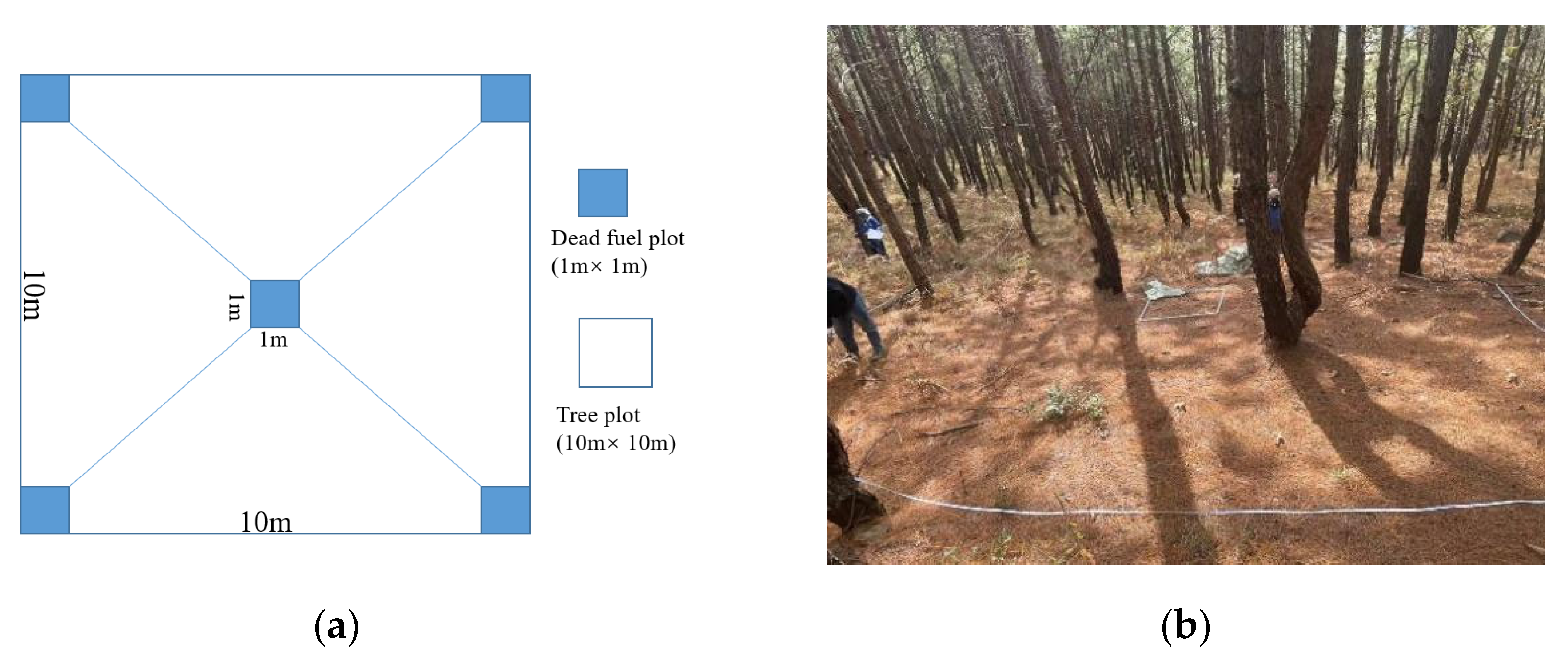

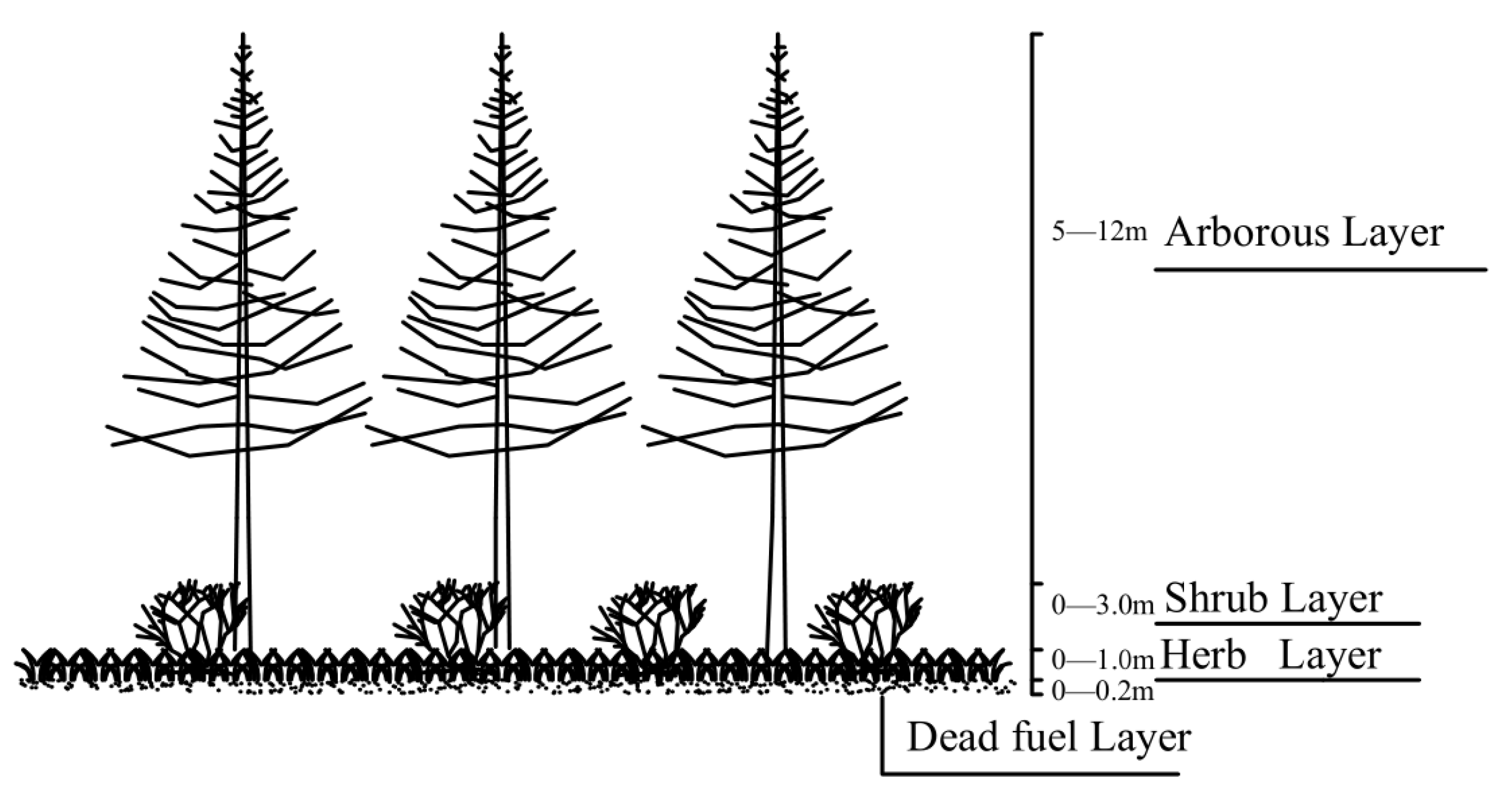


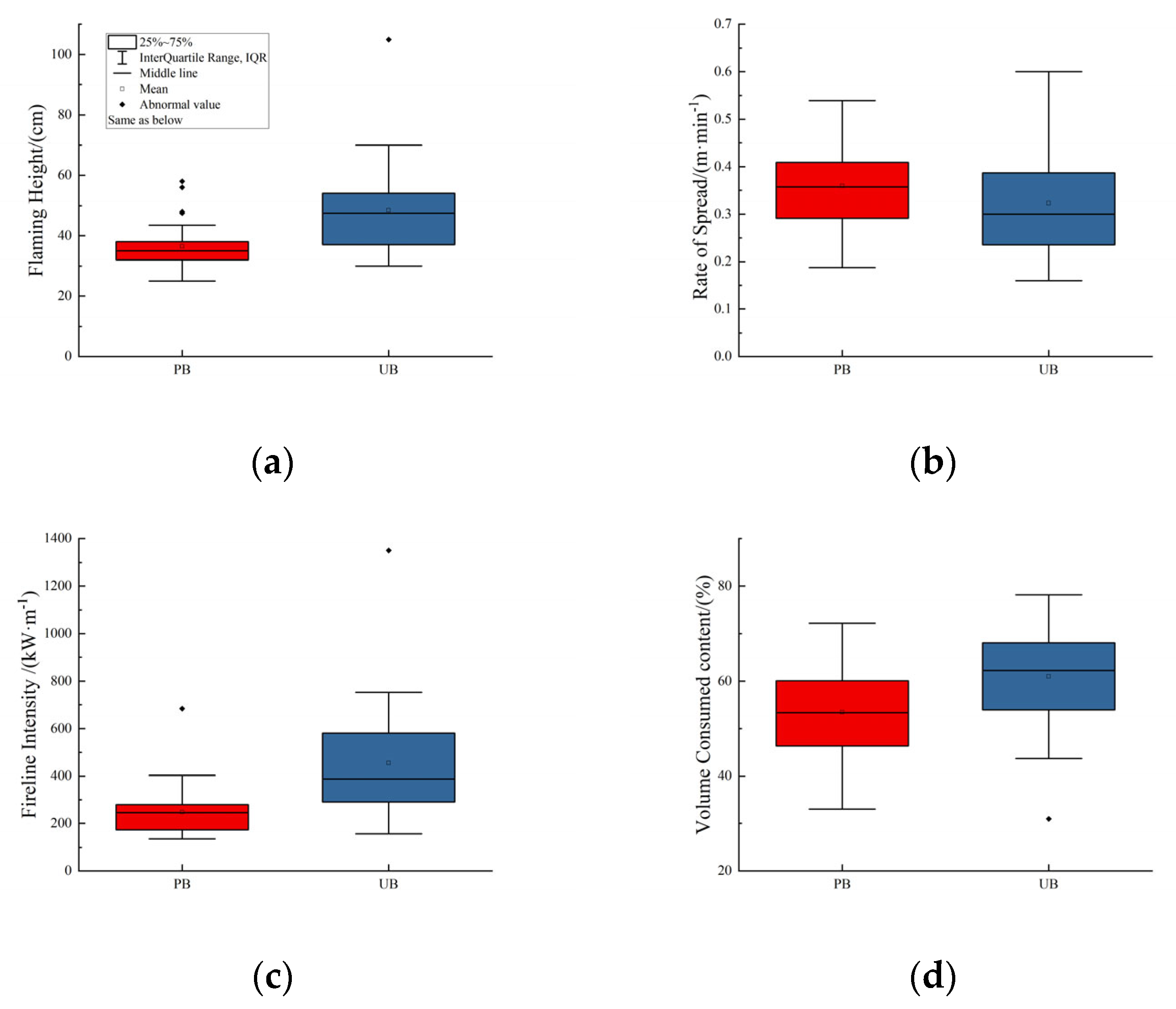
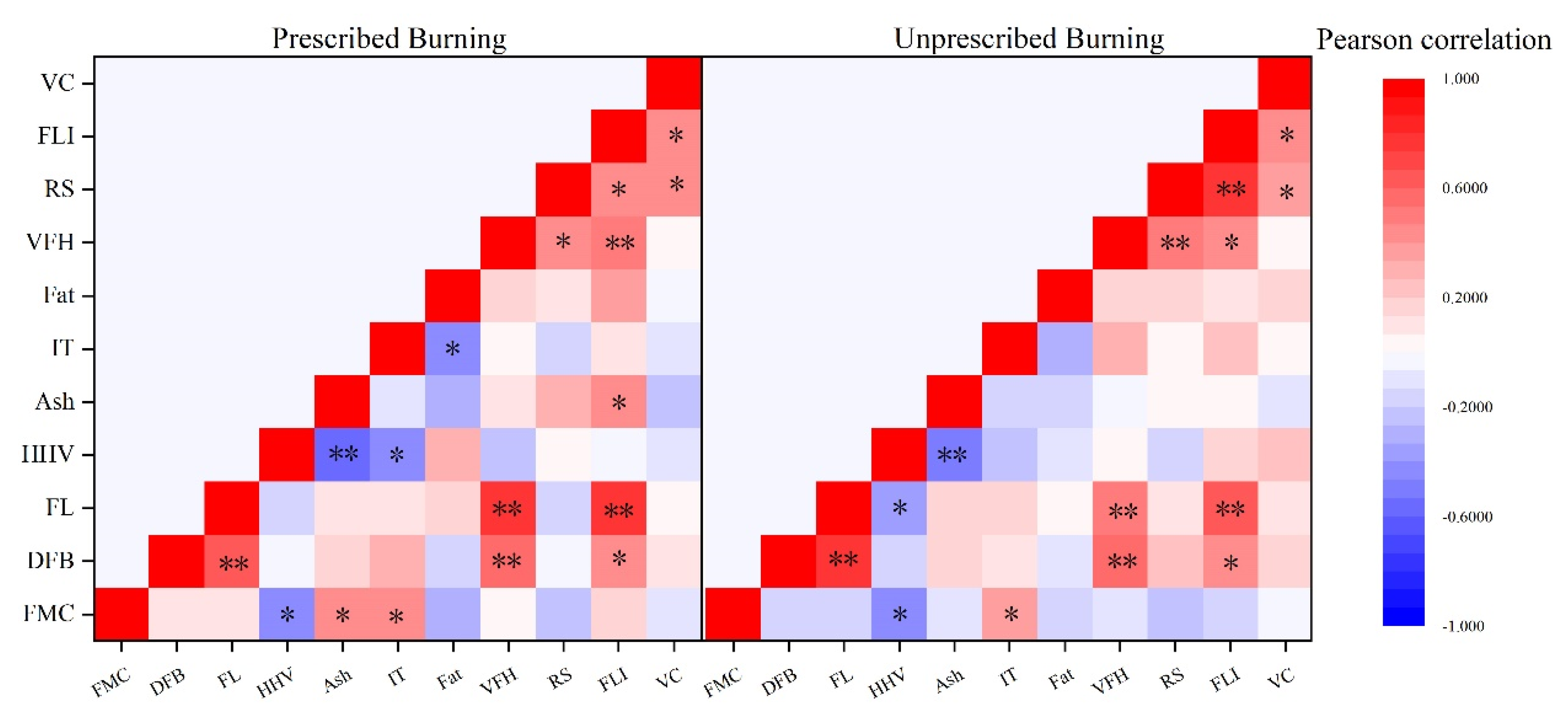
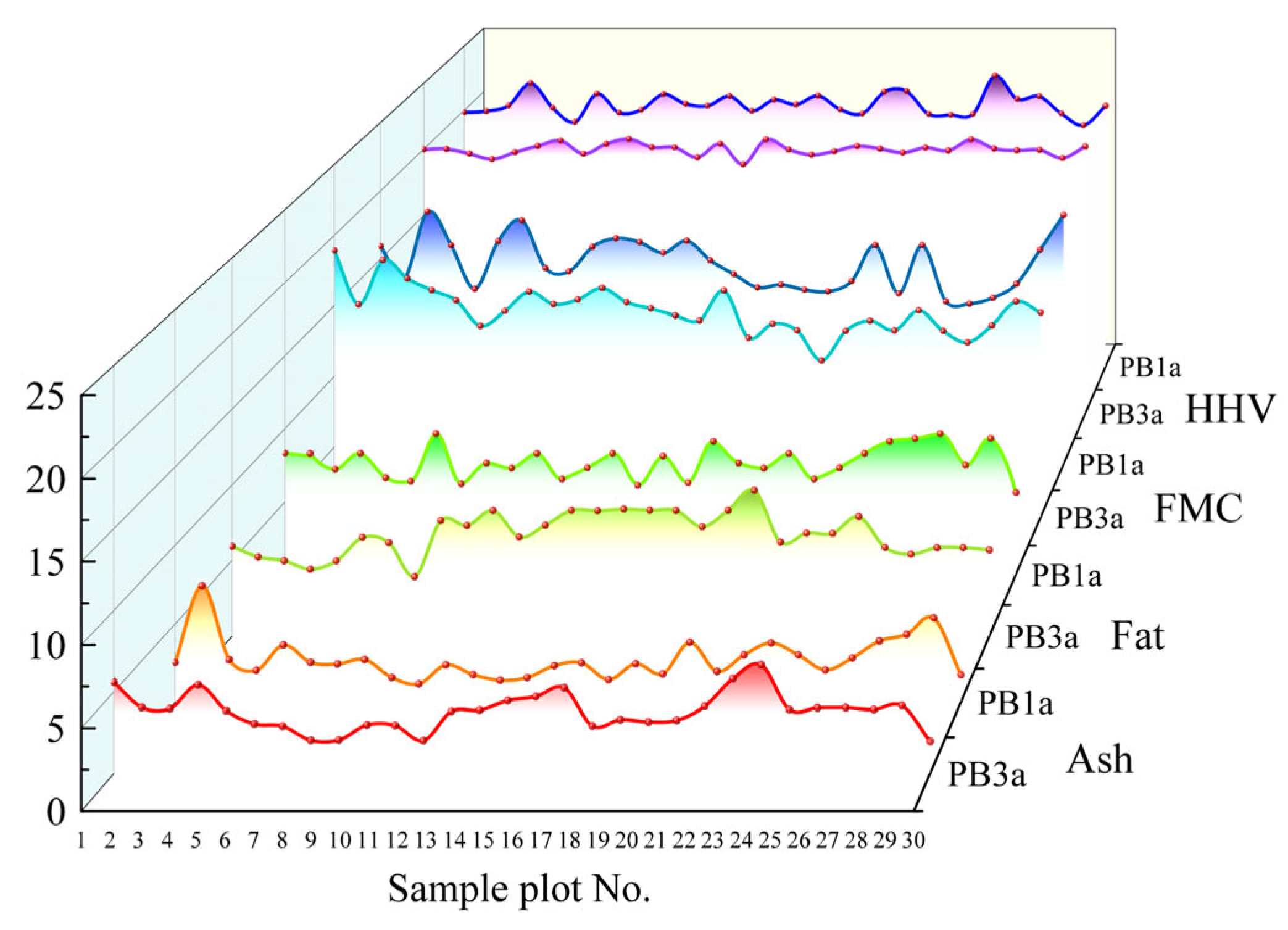
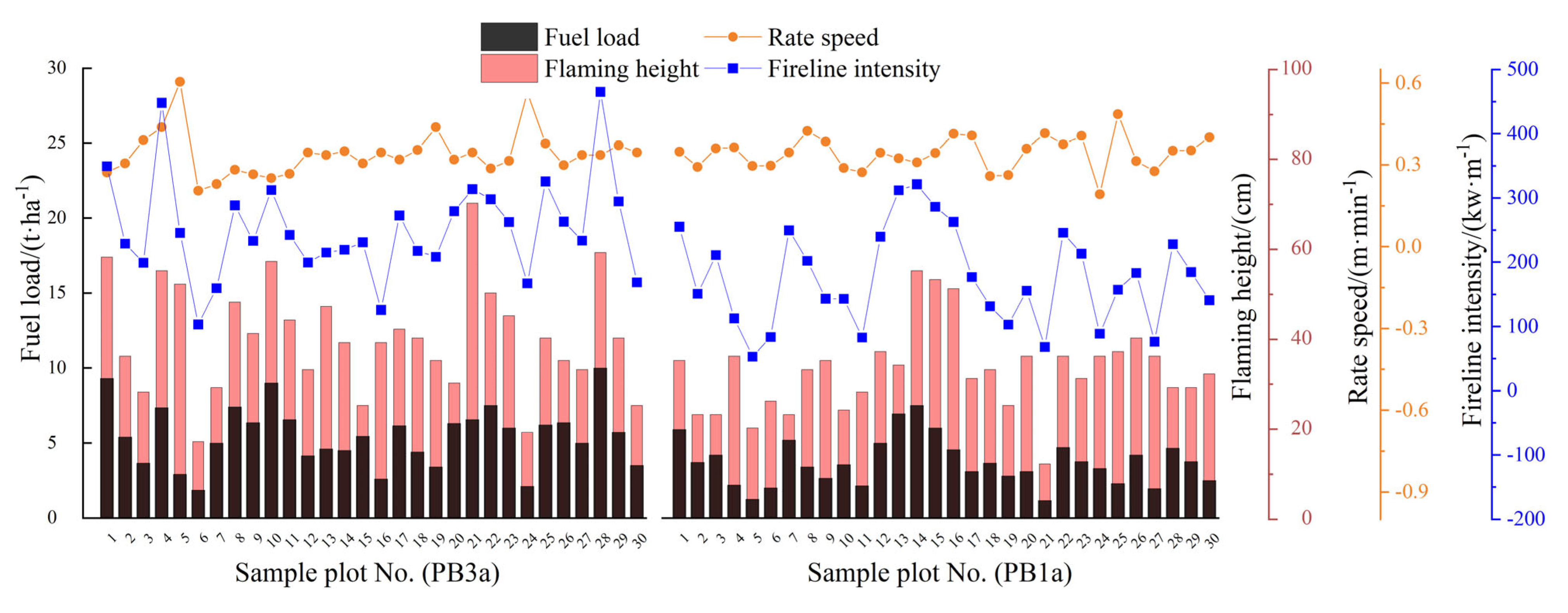
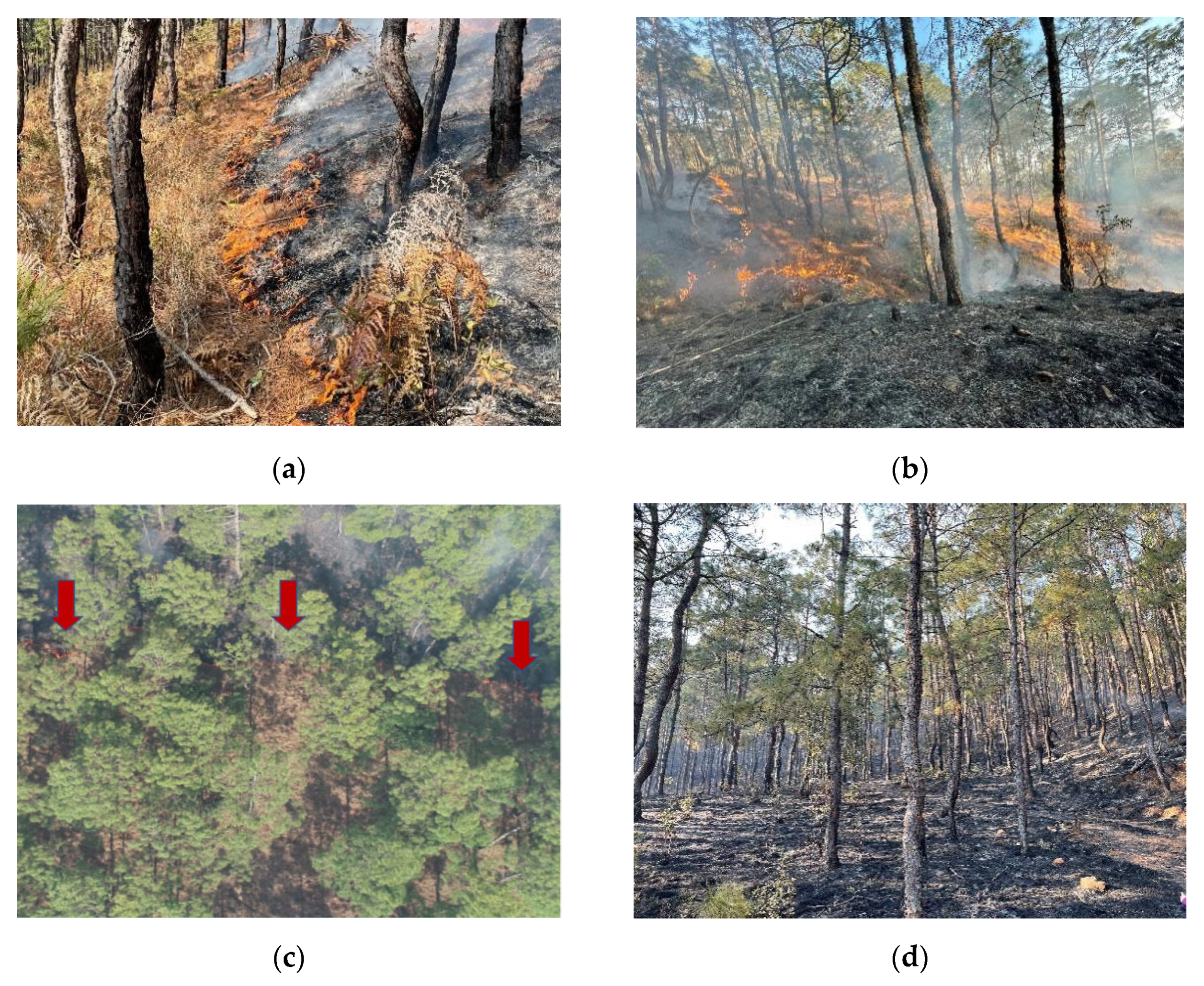
| Treatment | Altitude (m) | Slope (°) | Overstory Cover (%) | Tree Density 2 (No./ha) | DBH (cm) | Height (m) | Under-Branch Height (m) |
|---|---|---|---|---|---|---|---|
| Mean (SE) 1 | |||||||
| UB | 2010–2050 | 6–25 | 0.47 | 1481 | 17.1 (1.0) | 11.0 (1.3) | 5.7 (1.6) |
| PB1a | 1800–2000 | 10–37 | 0.54 | 1170 | 16.5 (0.8) | 10.3 (2.1) | 7.3 (1.2) |
| PB3a | 0.55 | 1198 | 17.1 (1.3) | 11.3 (1.5) | 7.6 (1.4) | ||
| Treatments | Herbaceous Cover (%) | Shrub Cover (%) | Herb Height (cm) | Shrub Height (cm) |
|---|---|---|---|---|
| Mean (SE) 1 | ||||
| PB | 75–90 | 25–35 | 48.8 (10.2) a 2 | 58.8 (19.9) a |
| UB | 55–80 | 65–80 | 54.2 (7.6) a | 226.2 (56.7) b |
| Pairing Difference | t | Significance (Two Tails) | |||||
|---|---|---|---|---|---|---|---|
| Sample | Average | SD | MSD | CID | |||
| Lower Limit | Upper Limit | ||||||
| FMC | −0.0586 | 3.7290 | 0.6808 | −1.4510 | 1.3338 | −0.08 | 0.932 |
| DFB | −2.533 | 1.8519 | 0.3381 | −3.2248 | −1.8417 | −7.49 | 0.000 |
| FL | −0.5188 | 0.3876 | 0.0707 | −0.6635 | −0.3740 | −7.33 | 0.000 |
| HHV | −81.4124 | 1328.3941 | 242.5304 | −577.4429 | 414.6180 | −0.33 | 0.740 |
| Ash | −0.1256 | 1.4665 | 0.2677 | −0.6732 | 0.4220 | −0.46 | 0.642 |
| IT | −0.5459 | 4.5110 | 0.8236 | −2.2304 | 1.1385 | −0.66 | 0.513 |
| Fat | −0.2982 | 2.0127 | 0.3674 | −1.0498 | 0.4532 | −0.81 | 0.524 |
| VFH | −12.0500 | 18.3830 | 3.3562 | −18.9143 | −5.1856 | −3.59 | 0.001 |
| RS | 0.0361 | 0.1580 | 0.0288 | −0.0228 | 0.0951 | 1.25 | 0.220 |
| FLI | −208.6519 | 300.9631 | 54.9481 | −321.0334 | −96.2705 | −3.79 | 0.001 |
| VC | −11.7991 | 13.1720 | 2.4048 | −16.7176 | −6.8806 | −4.90 | 0.000 |
Disclaimer/Publisher’s Note: The statements, opinions and data contained in all publications are solely those of the individual author(s) and contributor(s) and not of MDPI and/or the editor(s). MDPI and/or the editor(s) disclaim responsibility for any injury to people or property resulting from any ideas, methods, instructions or products referred to in the content. |
© 2023 by the authors. Licensee MDPI, Basel, Switzerland. This article is an open access article distributed under the terms and conditions of the Creative Commons Attribution (CC BY) license (https://creativecommons.org/licenses/by/4.0/).
Share and Cite
Wang, J.; Hong, R.; Ma, C.; Zhu, X.; Xu, S.; Tang, Y.; Li, X.; Yan, X.; Wang, L.; Wang, Q. Effects of Prescribed Burning on Surface Dead Fuel and Potential Fire Behavior in Pinus yunnanensis in Central Yunnan Province, China. Forests 2023, 14, 1915. https://doi.org/10.3390/f14091915
Wang J, Hong R, Ma C, Zhu X, Xu S, Tang Y, Li X, Yan X, Wang L, Wang Q. Effects of Prescribed Burning on Surface Dead Fuel and Potential Fire Behavior in Pinus yunnanensis in Central Yunnan Province, China. Forests. 2023; 14(9):1915. https://doi.org/10.3390/f14091915
Chicago/Turabian StyleWang, Jin, Ruicheng Hong, Cheng Ma, Xilong Zhu, Shiying Xu, Yanping Tang, Xiaona Li, Xiangxiang Yan, Leiguang Wang, and Qiuhua Wang. 2023. "Effects of Prescribed Burning on Surface Dead Fuel and Potential Fire Behavior in Pinus yunnanensis in Central Yunnan Province, China" Forests 14, no. 9: 1915. https://doi.org/10.3390/f14091915
APA StyleWang, J., Hong, R., Ma, C., Zhu, X., Xu, S., Tang, Y., Li, X., Yan, X., Wang, L., & Wang, Q. (2023). Effects of Prescribed Burning on Surface Dead Fuel and Potential Fire Behavior in Pinus yunnanensis in Central Yunnan Province, China. Forests, 14(9), 1915. https://doi.org/10.3390/f14091915






